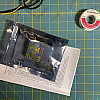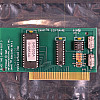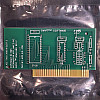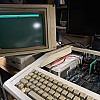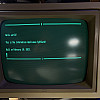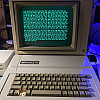Raskin
Assembling and running a replica SwyftCard, the first product from Information Appliances and predecessor to the Canon Cat.
History
Jef Raskin started the Macintosh program at Apple as a skunkworks project in the early 80's. His vision was to develop a computer that was easy to use -- the computer as an appliance. Famously, Steve Jobs took over the Macintosh team, fired Raskin, and developed the Macintosh computer based on the desktop concept, which was based on projects at Xerox PARC and was also the basic design of the Apple Lisa.
After leaving Apple, Raskin started Information Appliance, Inc. to realize his own vision. Their first product was the Swyft Card, a peripheral card that converted an Apple IIe to an Swyft "appliance computer." It tested the early concepts of a computer which would later become the short-lived Canon Cat.
The essential idea behind the Swyft Card and the later Cat focuses on text manipulation. The user works in a space of continuous text. Key sequences, not too dissimilar from meta-keys, enable the user to move around the text quickly. Simple programs and calculations can be incorporated into the text. The Swyft Card uses an unformatted floppy (5.25") disk to store data. It stores and retrieves text quickly. Each disk can hold about ten or so pages of text.
Here's how the SwyftCard manual describes the Swyft system:
Notes
I build a replica Swyft Card produced by Mike Willegal to try out Jef Raskin's idea. The card installs into slot 3 of a stock Apple IIe and catches the boot process. If a specially (un)formatted disk is available, it boots into the Swyft system. Otherwise, the machine will continue booting into ProDOS or (presumably) DOS 3.3, depending on the disk in the drive.
Here are a few images of the card before and after assembling it and its operation:
Raskin had a keen observation that we rarely want to take our hands off of the keyboard. Even in a desktop environment, keyboard "shortcuts" make it possible to quickly navigate between applications. We relegate them to "shortcuts" which, unfortunately, become a little arcane, but really they are a powerful way of navigating a modern system. When I want to create a drawing or illustration, I use the mouse. When I write, I want to move quickly around the text. There are tasks, though, that still require the mouse because each application has its own "shortcuts" or there are a confusing number of them.
The Swyft documentation states that the system is written in FORTH and Assembly, which accounts for its fast speed. Its limited features make it quick and responsive. Perhaps Jef Raskin was on to something. At least for a general writing application, it performs very well. The concept of not taking you hands off of the keyboard is suitable for many types of work. How would it have adapted to email, newsgroups, and other applications? I need to write documents, communicate by email, research information on the internet, and share information on my website and other platforms (currently Mastodon). It would have been interesting to see how the Canon Cat could have evolved. Would it have switched between (text-based) applications? What if the Swyft machine was connected to other users with the ability to share files?
But on the Swyft system, I cannot make a presentation or an illustration for an article. I can't plot and analyze data. (Did the Canon Cat have these features?) As a pure writing application, though, it is fairly powerful. As I generate more text, it will be intersting to see how I navigate it and find text. Would writing a book be straightforward on the Swyft system? Taking and organizing notes? Are there sort features that I've missed? Making a list and reordering it would be nice. Keeping a to-do list would be helpful. One can imagine later having color coding by context. It could be a powerful developer platform. I would enjoy writing LaTeX on such a machine, especially if it gave me the option to pop up the rendered document.
Imagine if I started a fresh disk each day. The first page could be my to-do list. I could have copied this from the last day's disk with remaining tasks. My next pages would be the work corresponding to the list. I would have a lot of disks. But perhaps I only need one disk a week? How did people end up usin the Canon Cat? Did anyone adapt it to a daily workflow? What did they discover? What was missing? What were its strengths?
Resources
Jef Raskin Wikipedia page:
Raskin Archive at IA:
Mike Willegal demoed the replica at VCF in 2008:
Eric Rangell created a bootable floppy of the Swyft system:
- https://github.com/erangell/kfest2021
- https://archive.org/details/swyftware-a2r-woz
- https://archive.org/details/swyft-data-disk-a2r

